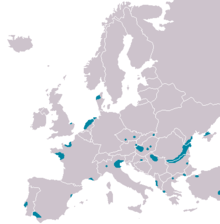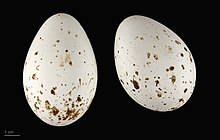Eurasian spoonbill
| Eurasian spoonbill | |
|---|---|

| |
| Adult in breeding plumage | |
| Scientific classification | |
| Domain: | Eukaryota |
| Kingdom: | Animalia |
| Phylum: | Chordata |
| Class: | Aves |
| Order: | Pelecaniformes |
| Family: | Threskiornithidae |
| Genus: | Platalea |
| Species: | P. leucorodia
|
| Binomial name | |
| Platalea leucorodia | |

| |
| Breeding range in Europe in blue (also in Asia and Africa, not shown) | |
The Eurasian spoonbill (Platalea leucorodia), or common spoonbill, is a wading
Taxonomy and systematics
A study of mitochondrial DNA of the spoonbills found that the Eurasian spoonbill is sister taxon to a clade containing the royal and black-faced spoonbills.[4]
The Eurasian spoonbill has three subspecies:[5]
- P. l. leucorodia – nominate, occupies all the range except as below.
- P. l. balsaci – Banc d'Arguin, Mauritania.
- P. l. archeri – Neumann, 1928: found on the coasts of the Red Sea and Somalia.
Birds in Asia are sometimes separated as P. l. major.
Description
This species is almost unmistakable in most of its range. The breeding bird is all white except for its dark legs, black bill with a yellow tip, and a yellow breast patch like a pelican. It has a crest in the breeding season. Non-breeders lack the crest and breast patch, and immature birds have a pale bill and black tips to the primary flight feathers. Unlike herons, spoonbills fly with their necks outstretched. The Eurasian spoonbill differs from the African spoonbill with which in overlaps in winter, in that the latter species has a red face and legs, and no crest.
They are mostly silent. Even at their breeding colonies the main sounds are bill snapping, occasional deep grunting and occasional trumpeting noises.
Distribution and habitat


This species is found widely in Europe, Asia and Africa. In Europe, it breeds from the United Kingdom and Portugal in the west, locally through the continent; ranging north to Denmark and east to the
Eurasian spoonbills show a preference for extensive, shallow wetlands with muddy clay and/or fine, sandy beds. They may inhabit any type of marsh, river, lake, floodplain, bog or
Behaviour and ecology
Breeding


More northerly breeding populations are fully migratory but may only migrate short distances while other, more southerly populations are resident and nomadic or partially migratory. In the
The nest is a platform of sticks and vegetation which is either constructed on the ground on islands in lakes and rivers or in dense stands of reeds, bushes, mangroves or deciduous trees up to 5 m (16 ft) above the ground. Within colonies neighbouring nests are usually quite close together, no more than 1 or 2 m (3.3 or 6.6 ft) apart. Breeding colonies are normally sited within 10–15 km (6.2–9.3 mi) of feeding areas, often much less (although the species may also feed up to 35–40 km (22–25 mi) away).[1]
Feeding
The diet consists of aquatic
Conservation
Overall, the Eurasian spoonbill is not threatened and the total global population was estimated at 63–65,000 mature birds in 2015.
Threats to the Eurasian spoonbill include habitat loss and degradation by drainage and pollution, it is especially adversely affected by the disappearance of reed swamps. In Greece disturbance from fishing once caused the population to decline, and human exploitation of eggs and nestlings for food has threatened the species in the past.[1] Breeding colonies are highly vulnerable to general disturbances and predators like red fox.[16][19] Consequently, colonies are often restricted to islands free of ground predators;[13] however, in some places, pairs in mainland colonies may breed successfully by nesting off the ground in trees and bushes.[11]
The research network Eurasian Spoonbill International Expert Group was formed in 1991.[20] It made an action plan for the bird in 2008.[21] In 2013 the group joined the Agreement on the Conservation of African-Eurasian Migratory Waterbirds.
Gallery
-
Nestlings
-
Immature Eurasian spoonbill, Bundala National Park
-
ID composite
-
1726 drawing by Jacobus Houbraken
-
Hieronymus Bosch: The Garden of Earthly Delights, 15th century
-
New International Encyclopedia, 1902
References
- ^ . Retrieved 21 March 2022.
- ^ "Appendices | CITES". cites.org. Retrieved 2022-01-14.
- ISBN 978-1-4081-2501-4.
- ISSN 1175-5326.
- . Retrieved 10 July 2017.
- ^ "Spoonbill". RSPB. Retrieved 21 May 2022.
- ISBN 0563 38792 0
- ISBN 9780946888528.
- ^ "European Red List of Birds" (PDF). BirdLife Europe. 1 August 2021. Retrieved 21 May 2022.
- ^ Lok, T.; Overdijk, O.; Horn, H.; Piersma, T. (2009). "De lepelaarpopulatie van de Waddenkomt het einde van de groei in zicht?". Limosa. 82: 149–157.
- ^ S2CID 90180890.
- ISBN 978-90-5011-161-4.
- ^ a b Nyegaard, T.; Meltofte, H.; Tofft, J.; Grell, M.B. (2014). "Truede og sjældne ynglefugle i Danmark 1998-2012". Dansk Ornitologisk Forenings Tidsskrift. 108 (1).
- ^ a b Holm, TS; et al. (2020). "Fugle 2018-2019, NOVANA" (PDF). Aarhus University. Retrieved 29 June 2022.
- ^ "Varmere klima sender flere fuglearter nordpå til Danmark". Dansk Ornitologisk Forening (Danish Ornithological Society). 18 June 2022. Retrieved 29 June 2022.
- ^ a b "Mange skestorke flokkes i det våde danske sommerland". Dansk Ornitologisk Forening (Danish Ornithological Society). 26 July 2017. Retrieved 21 May 2022.
- ^ a b "Breeding spoonbills return to Holkham". 12 September 2011. Archived from the original on 5 June 2014.
- ^ Unwin, Brian (27 August 2000). "Spoonbills return to breed in the UK after 300 years". The Independent. London.
- ^ a b c "Focus on: Eurasian Spoonbill". BirdGuides. 2 July 2020. Retrieved 21 May 2022.
- ^ "AEWA International Species Expert Groups (ISEG) | AEWA".
- ^ "International Single Species Action Plan for the Conservation of the Eurasian Spoonbill (Complete) (TS No.35) | AEWA".
External links
- BirdLife species factsheet for Platalea leucorodia
- "Platalea leucorodia". Avibase.
- "Eurasian spoonbill media". Internet Bird Collection.
- Eurasian spoonbill photo gallery at VIREO (Drexel University)
- Interactive range map of Platalea leucorodia at IUCN Red List maps
- Audio recordings of Eurasian spoonbill on Xeno-canto.







